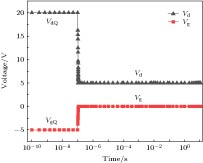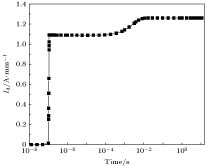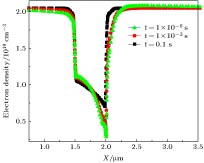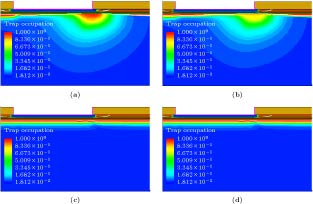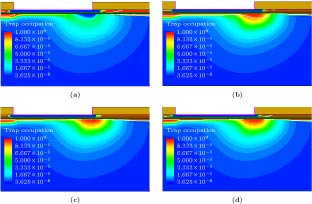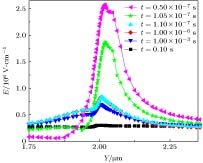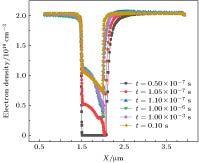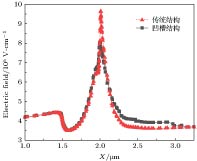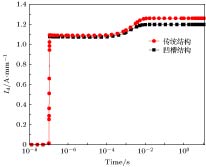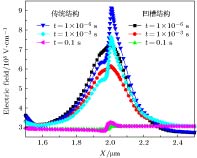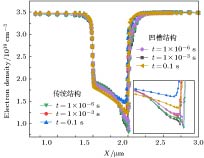-
Due to the excellent properties of GaN, such as wide band gap, high electron mobility, high saturation speed, and high breakdown electric field, AlGaN/GaN high electron mobility transistor (HEMT) possesses highly promising applications in the fields of high power, radio frequency, and high temperature applications. However, they are still subjected to the influence of current collapse which strangles its development. Based on the double-pulse technique, the effect of GaN buffer layer trap on the current collapse of AlGaN/GaN HEMT is studied. The results show that the electric field peak at the gate edge is one of the main causes of current collapse. The channel electrons are trapped by the buffer trap under the peak electric field. Because the response speed of the trap in the buffer layer is slow, the channel can not be turned on immediately after the gate voltage has jumped to 0 V, which leads the current to collapse. In this paper, the new structure is proposed by introducing a groove structure in the barrier layer. The channel two-dimensional electron gas is modulated by the groove structure, which influences the channel electric field of AlGaN/GaN HEMT device, reduces the electric field peak at the gate edge, and improves the current collapse effect of the device. Comparing with the traditional AlGaN/GaN HEMT, the inhibition effect of the new device structure on current collapse is increased by 22.30%. The length and height of the groove structure are the critical parameters to affect the new HEMT performance. The optimal parameters of length and hight show that when the length of the groove is 1 μm and the height is 0.01 μm, the current collapse of HEMT and its performance are significantly improved.
-
Keywords:
- AlGaN/GaN /
- high electron mobility transistor /
- current collapse /
- buffer layer trap
[1] Lin Z T, Chen X F, Zhu Y H, Chen X W, Huang L G, Li G Q 2018 IEEE Trans. Electron Dev. 65 5373
 Google Scholar
Google Scholar
[2] Zhao L X, Zhu S C, Wu C H, Yang C, Yu Z G, Yang H, Liu L 2016 Sci. China: Phys. Mech. Astron. 59 107301
 Google Scholar
Google Scholar
[3] Zhao L X, Yu Z G, Sun B, Zhu S C, An P B, Yang C, Liu L, Wang J X, Li J M 2015 Chin. Phy. B 24 068506
 Google Scholar
Google Scholar
[4] Chen K J, Häberlen O, Lidow A, Tsai C L, Ueda T, Uemoto Y, Wu Y F 2017 IEEE Trans. Electron Dev. 64 779
 Google Scholar
Google Scholar
[5] 余晨辉, 罗向东, 周文政, 罗庆洲, 刘培生 2012 物理学报 61 207301
 Google Scholar
Google Scholar
Yu C H, Luo X D, Zhou W Z, Luo Q Z, Liu P S 2012 Acta Phys. Sin. 61 207301
 Google Scholar
Google Scholar
[6] Radhakrishna U, Choi P, Antoniadis D A 2019 IEEE Trans. Electron Dev. 66 95
 Google Scholar
Google Scholar
[7] Zhang C, Wang M, Xie B, Wen C P, Wang J Y, Hao Y L, Wu W G, Chen K J, Shen B 2015 IEEE Trans. Electron Dev. 62 2475
 Google Scholar
Google Scholar
[8] Meneghini M, Rossetto I, Bisi D, Stocco A, Pantellini A, Meneghesso G, Zanoni E 2014 IEEE Trans. Electron Dev. 61 4070
 Google Scholar
Google Scholar
[9] Miccoli C, Martino V C, Reina S, Rinaudo S 2013 IEEE Electron Dev. Lett. 34 1121
 Google Scholar
Google Scholar
[10] del Alamo J A, Lee E S 2019 IEEE Trans. Electron Dev. 66 4578
 Google Scholar
Google Scholar
[11] Gan C L, Sasangka W A, Thompson C V 2019 Electron Devices Technology and Manufacturing Conference Singapore, March 12−15, 2019 p71
[12] 周幸叶, 吕元杰, 谭鑫, 王元刚, 宋旭波, 何泽召, 张志荣, 刘庆彬, 韩婷婷, 房玉龙, 冯志红 2018 物理学报 67 178501
 Google Scholar
Google Scholar
Zhou X Y, Lv Y J, Tan X, Wang Y G, Song X B, He Z Z, Zhang Z R, Liu Q B, Han T T, Fang Y L, Feng Z H 2018 Acta Phys. Sin. 67 178501
 Google Scholar
Google Scholar
[13] Ghosh S, Das S, Dinara S M, Bag A, Chakraborty A, Mukhopadhyay P, Jana S K, Biswas D 2018 IEEE Trans. Electron Dev. 65 1333
 Google Scholar
Google Scholar
[14] Subramani N K, Couvidat J, Hajjar A A, Nallatamby J C, Quéré R 2017 J. Electron Dev. Soc. 5 175
 Google Scholar
Google Scholar
[15] Vetury R, Zhang N Q, Keller S, Mishra U K 2001 IEEE Trans. Electron Dev. 48 560
 Google Scholar
Google Scholar
[16] Hwang I, Kim J, Chong S, Choi H S, Hwang S K, Oh J, Shin J K, Chung U I 2013 IEEE Electron Dev. Lett. 34 1494
 Google Scholar
Google Scholar
[17] Nakano K, Hanawa H, Horio K 2018 Workshop on Wide Bandgap Power Devices and Applications in Asia Xi'an, May 16–18, 2018 p131
[18] Kabemura T, Ueda S, Kawada Y, Horio K 2018 IEEE Trans. Electron Dev. 65 3848
 Google Scholar
Google Scholar
[19] Wang C H, Ho S Y, Huang J J 2016 IEEE Electron Dev. Lett. 37 74
 Google Scholar
Google Scholar
[20] Nishitani T, Yamaguchi R, Yamazaki T, Asubar J T, Tokuda H, Kuzuhara M 2018 IEEE International Meeting for Future of Electron Devices Kansai Kyoto, June 21–22, 2018 p1
[21] Koehler A D, Anderson T J, Tadjer M J, Weaver B D, Greenlee J D, Shahin D I, HobartK D, Kub F J 2016 IEEE Electron Dev. Lett. 37 545
 Google Scholar
Google Scholar
[22] Arakawa Y, Ueno K, Imabeppu H, Kobayashi A, Ohta J, Fujioka H 2017 Appl. Phys. Lett. 110 042103
 Google Scholar
Google Scholar
[23] Mukherjee K, Darracq F, Curutchet A, Malbert N, Labat N 2017 Microelectron. Reliab. 76 350
-
-
[1] Lin Z T, Chen X F, Zhu Y H, Chen X W, Huang L G, Li G Q 2018 IEEE Trans. Electron Dev. 65 5373
 Google Scholar
Google Scholar
[2] Zhao L X, Zhu S C, Wu C H, Yang C, Yu Z G, Yang H, Liu L 2016 Sci. China: Phys. Mech. Astron. 59 107301
 Google Scholar
Google Scholar
[3] Zhao L X, Yu Z G, Sun B, Zhu S C, An P B, Yang C, Liu L, Wang J X, Li J M 2015 Chin. Phy. B 24 068506
 Google Scholar
Google Scholar
[4] Chen K J, Häberlen O, Lidow A, Tsai C L, Ueda T, Uemoto Y, Wu Y F 2017 IEEE Trans. Electron Dev. 64 779
 Google Scholar
Google Scholar
[5] 余晨辉, 罗向东, 周文政, 罗庆洲, 刘培生 2012 物理学报 61 207301
 Google Scholar
Google Scholar
Yu C H, Luo X D, Zhou W Z, Luo Q Z, Liu P S 2012 Acta Phys. Sin. 61 207301
 Google Scholar
Google Scholar
[6] Radhakrishna U, Choi P, Antoniadis D A 2019 IEEE Trans. Electron Dev. 66 95
 Google Scholar
Google Scholar
[7] Zhang C, Wang M, Xie B, Wen C P, Wang J Y, Hao Y L, Wu W G, Chen K J, Shen B 2015 IEEE Trans. Electron Dev. 62 2475
 Google Scholar
Google Scholar
[8] Meneghini M, Rossetto I, Bisi D, Stocco A, Pantellini A, Meneghesso G, Zanoni E 2014 IEEE Trans. Electron Dev. 61 4070
 Google Scholar
Google Scholar
[9] Miccoli C, Martino V C, Reina S, Rinaudo S 2013 IEEE Electron Dev. Lett. 34 1121
 Google Scholar
Google Scholar
[10] del Alamo J A, Lee E S 2019 IEEE Trans. Electron Dev. 66 4578
 Google Scholar
Google Scholar
[11] Gan C L, Sasangka W A, Thompson C V 2019 Electron Devices Technology and Manufacturing Conference Singapore, March 12−15, 2019 p71
[12] 周幸叶, 吕元杰, 谭鑫, 王元刚, 宋旭波, 何泽召, 张志荣, 刘庆彬, 韩婷婷, 房玉龙, 冯志红 2018 物理学报 67 178501
 Google Scholar
Google Scholar
Zhou X Y, Lv Y J, Tan X, Wang Y G, Song X B, He Z Z, Zhang Z R, Liu Q B, Han T T, Fang Y L, Feng Z H 2018 Acta Phys. Sin. 67 178501
 Google Scholar
Google Scholar
[13] Ghosh S, Das S, Dinara S M, Bag A, Chakraborty A, Mukhopadhyay P, Jana S K, Biswas D 2018 IEEE Trans. Electron Dev. 65 1333
 Google Scholar
Google Scholar
[14] Subramani N K, Couvidat J, Hajjar A A, Nallatamby J C, Quéré R 2017 J. Electron Dev. Soc. 5 175
 Google Scholar
Google Scholar
[15] Vetury R, Zhang N Q, Keller S, Mishra U K 2001 IEEE Trans. Electron Dev. 48 560
 Google Scholar
Google Scholar
[16] Hwang I, Kim J, Chong S, Choi H S, Hwang S K, Oh J, Shin J K, Chung U I 2013 IEEE Electron Dev. Lett. 34 1494
 Google Scholar
Google Scholar
[17] Nakano K, Hanawa H, Horio K 2018 Workshop on Wide Bandgap Power Devices and Applications in Asia Xi'an, May 16–18, 2018 p131
[18] Kabemura T, Ueda S, Kawada Y, Horio K 2018 IEEE Trans. Electron Dev. 65 3848
 Google Scholar
Google Scholar
[19] Wang C H, Ho S Y, Huang J J 2016 IEEE Electron Dev. Lett. 37 74
 Google Scholar
Google Scholar
[20] Nishitani T, Yamaguchi R, Yamazaki T, Asubar J T, Tokuda H, Kuzuhara M 2018 IEEE International Meeting for Future of Electron Devices Kansai Kyoto, June 21–22, 2018 p1
[21] Koehler A D, Anderson T J, Tadjer M J, Weaver B D, Greenlee J D, Shahin D I, HobartK D, Kub F J 2016 IEEE Electron Dev. Lett. 37 545
 Google Scholar
Google Scholar
[22] Arakawa Y, Ueno K, Imabeppu H, Kobayashi A, Ohta J, Fujioka H 2017 Appl. Phys. Lett. 110 042103
 Google Scholar
Google Scholar
[23] Mukherjee K, Darracq F, Curutchet A, Malbert N, Labat N 2017 Microelectron. Reliab. 76 350
计量
- 文章访问数: 14941
- PDF下载量: 197
- 被引次数: 0














 下载:
下载:
